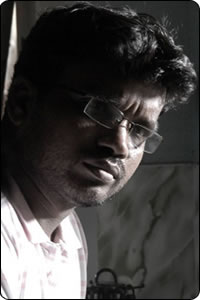| |
|
|
| |
 |
|
| FROM
VIKRAMAN TO ARIVAZHAGAN – THE EVOLUTION
OF TAMIL CINEMA |
|
| By
Behindwoods Visitor Manikandan K R |
|
| The
views expressed in this column are that of
the visitor. Behindwoods.com doesn't hold
responsible for its content. |
|
If
a picture is worth thousand
words, a video is worth million
words. However there were periods
in Tamil cinema when a thousand
words were spoken in a video
to convey one. Yes, the reference
I make here is about the era
of Vikraman block busters. Right
from Pudhu Vasantham to his
last film Vaanathai Pola, Vikraman
was an expert in pulling a three
hour script from a one line
story. Sometimes the stories
were shorter but the script
remained the same length. Perhaps
you can bring down the story
of any movie to one line but
you would most probably be summarizing
or paraphrasing to do so. But
Vikraman’s stories can
be elongated only by his scripts.
The cliché comedies by
Ramesh Kanna, Sundararajan and
Charlie would never have any
connection with the story. The
songs would always be ‘placed’
here and there. One can argue
that most of the commercial
films in Tamil followed this
formula but wait a minute and
please note that the movies
I am talking about are those
of a director who once was an
Ambassador of Tamil Cinema.
‘Four young talented musicians
who come up in life due to the
encouragement from a girl’
, ‘ a guy who takes all
the pain to make sure the girl
he loves succeeds in her love,
though she loves a different
person’, ‘a once-thief
helps a down-trodden girl realize
her dreams and is rewarded in
the end with her love’..
Like this all his stories can
be told in one line without
missing anything significant
in the script. When I say significant
I mean something other than
the must-have flashbacks, supposed
comedies, songs, the chorus
humming of a single tune that
haunts the entire length of
the movie, and last but not
least, the half-an-hour climax
dialogues in which the hero/heroine
quotes every possible analogy
to make his point clear to the
heroine/hero as though she/he
is a kindergarten student.
|
|
|
 |
|
|
|
It
is finally happy news that the Tamil cinema
audience are now coming out of the cocoons
built by such directors. They now understand
that a movie is not just a three hour elongated
recital of a Thirukural. The signs are clear.
I have been to theatres where the last 20
minutes of non-stop oration from Vijay in
Poove Unakaga received claps after every
period and now when I see the same audience
clap during a scene in Eeram where an annoyed
stare from Saranya Mohan is followed by
the sound of falling vessels (not a word
spoken), I could see the sign. That applause
was for the thousand words that the video
told in 2 seconds. This shows the evolution
of both - the screenplays and the audience’s
taste. Eeram is one of the first Tamil movies
I had seen where people applauded for the
brilliance in screenplay, cinematography
and sound editing. Of course credit should
also be given to people like Shankar who
not only identify budding talent but also
encourage them to take that extra bit of
risk and innovate. Eeram was one of a kind
in that aspect. Especially the screenplay
displayed the immense talent in Arivazhagan.
My personal best is the scene where the
housewives of the apartment have a gossip
while buying vegetables followed by a 180
degree shot of the apartment complex with
the cell phone tones heard in the background.
What a subtle yet efficient way of telling
that the gossip had spread throughout the
apartment. Sheer brilliance of the director!
The commercial success of Eeram and the
lukewarm response to the likes of Vikraman
movies these days clearly tell that the
audiences are catching up. They are now
ready to accept and appreciate the art in
the once considered technicalities of a
movie – the camera angle of a particular
shot, the lighting, the sound, the absence
of sound, the aptly timed pause- and have
now come to understand that it is these
technicalities that differentiate a movie
from any other video and thereby make it
a piece of art.
That said, I am not taking all credits away
from Vikraman. He is still the man who was
responsible for ‘the’ turning
points in the careers of Vijay, Karthik
and to an extent Vijayakanth. But one has
to evolve with the industry to survive.
Veterans like KB, Bharathiraja and even
KSR have failed to cope with the growing
trends and tastes. And if there is one man
who cannot be deterred or brought down by
such changing trends and cannot be stopped
from giving good movies, it is the legend
who has been taking Tamil cinema to the
world and beyond for the past 25 years–
Mani Ratnam.
Thanks,
Manikandan K R
orangedusk@gmail.com
|
| |
The
visitor claims that this column is his/her
own. If the column infringes any copyrights
that you hold, please email us.
If
you would like your own articles to be published,
please send them to  |
|
|
|
|
| |
|
|
|
|
|









